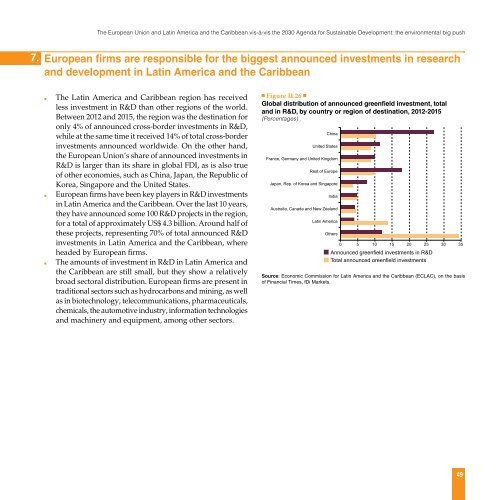La Unión Europea y América Latina y el Caribe ante la Agenda 2030 para el Desarrollo Sostenible: el gran impulso ambiental
Desde todas las regiones del planeta se observa con preocupación el aumento de la desigualdad global y la agudización de la crisis ambiental, especialmente en el caso del cambio climático. Frente a la complejidad de la situación, la comunidad internacional se ha movilizado a través de un extenso debate multilateral para ofrecer una respuesta amplia y ambiciosa. En los últimos meses se han puesto en marcha una serie de acciones colectivas que apuntan hacia un nuevo paradigma de desarrollo más sostenible e igualitario. En septiembre de 2015, la Asamblea General de las Naciones Unidas aprobó la Agenda 2030 para el Desarrollo Sostenible y los 17 Objetivos de Desarrollo Sostenible (ODS), con el reconocimiento de que el cambio climático y el desarrollo son inseparables. En esta línea, en diciembre de 2015 se aprobó el Acuerdo de París, en el que tanto naciones industrializadas como países en desarrollo se comprometen a gestionar la transición hacia una economía baja en carbono.
Desde todas las regiones del planeta se observa con preocupación el aumento de la desigualdad global y la agudización de la crisis ambiental, especialmente en el caso del cambio climático.
Frente a la complejidad de la situación, la comunidad internacional se ha movilizado a través de un extenso debate multilateral para ofrecer una respuesta amplia y ambiciosa. En los últimos meses se han puesto en marcha una serie de acciones colectivas que apuntan hacia un nuevo paradigma de desarrollo más sostenible e igualitario. En septiembre de 2015, la Asamblea General de las Naciones Unidas aprobó la Agenda 2030 para el Desarrollo Sostenible y los 17 Objetivos de Desarrollo Sostenible (ODS), con el reconocimiento de que el cambio climático y el desarrollo son inseparables. En esta línea, en diciembre de 2015 se aprobó el Acuerdo de París, en el que tanto naciones industrializadas como países en desarrollo se comprometen a gestionar la transición hacia una economía baja en carbono.
You also want an ePaper? Increase the reach of your titles
YUMPU automatically turns print PDFs into web optimized ePapers that Google loves.
The <strong>Europea</strong>n Union and <strong>La</strong>tin America and the Caribbean vis-à-vis the <strong>2030</strong> <strong>Agenda</strong> for Sustainable Dev<strong>el</strong>opment: the environmental big push<br />
7. <strong>Europea</strong>n firms are responsible for the biggest announced investments in research<br />
and dev<strong>el</strong>opment in <strong>La</strong>tin America and the Caribbean<br />
■■<br />
■■<br />
■■<br />
The <strong>La</strong>tin America and Caribbean region has received<br />
less investment in R&D than other regions of the world.<br />
Between 2012 and 2015, the region was the destination for<br />
only 4% of announced cross-border investments in R&D,<br />
while at the same time it received 14% of total cross-border<br />
investments announced worldwide. On the other hand,<br />
the <strong>Europea</strong>n Union’s share of announced investments in<br />
R&D is <strong>la</strong>rger than its share in global FDI, as is also true<br />
of other economies, such as China, Japan, the Republic of<br />
Korea, Singapore and the United States.<br />
<strong>Europea</strong>n firms have been key p<strong>la</strong>yers in R&D investments<br />
in <strong>La</strong>tin America and the Caribbean. Over the <strong>la</strong>st 10 years,<br />
they have announced some 100 R&D projects in the region,<br />
for a total of approximat<strong>el</strong>y US$ 4.3 billion. Around half of<br />
these projects, representing 70% of total announced R&D<br />
investments in <strong>La</strong>tin America and the Caribbean, where<br />
headed by <strong>Europea</strong>n firms.<br />
The amounts of investment in R&D in <strong>La</strong>tin America and<br />
the Caribbean are still small, but they show a r<strong>el</strong>ativ<strong>el</strong>y<br />
broad sectoral distribution. <strong>Europea</strong>n firms are present in<br />
traditional sectors such as hydrocarbons and mining, as w<strong>el</strong>l<br />
as in biotechnology, t<strong>el</strong>ecommunications, pharmaceuticals,<br />
chemicals, the automotive industry, information technologies<br />
and machinery and equipment, among other sectors.<br />
Figure II.26<br />
Global distribution of announced greenfi<strong>el</strong>d investment, total<br />
and in R&D, by country or region of destination, 2012-2015<br />
(Percentages)<br />
China<br />
United States<br />
France, Germany and United Kingdom<br />
Rest of Europe<br />
Japan, Rep. of Korea and Singapore<br />
India<br />
Australia, Canada and New Zea<strong>la</strong>nd<br />
<strong>La</strong>tin America<br />
Others<br />
0 5 10 15 20 25 30 35<br />
Announced greenfi<strong>el</strong>d investments in R&D<br />
Total announced greenfi<strong>el</strong>d investments<br />
Source: Economic Commission for <strong>La</strong>tin America and the Caribbean (ECLAC), on the basis<br />
of Financial Times, fDi Markets.<br />
49


















